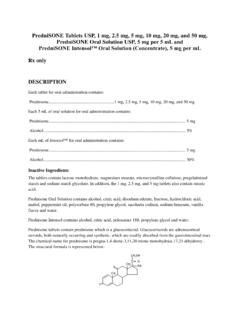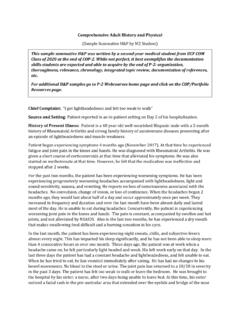Transcription of Unexplained Lymphadenopathy: Evaluation and …
1 896 American Family Physician Volume 94, Number 11 December 1, 2016 lymphadenopathy is benign and self-limited in most patients. Etiologies include malignancy, infection, and autoim-mune disorders, as well as medications and iatrogenic causes. The history and physical examination alone usually identify the cause of lymphadenopathy . When the cause is unknown, lymphadenopathy should be classified as local-ized or generalized. Patients with localized lymphadenopathy should be evaluated for etiologies typically associated with the region involved according to lymphatic drainage patterns.
2 Generalized lymphadenopathy , defined as two or more involved regions, often indicates underlying systemic disease. Risk factors for malignancy include age older than 40 years, male sex, white race, supraclavicular location of the nodes, and presence of systemic symptoms such as fever, night sweats, and Unexplained weight loss. Palpable supraclavicular, popliteal, and iliac nodes are abnormal, as are epitrochlear nodes greater than 5 mm in diameter. The workup may include blood tests, imaging, and biopsy depend-ing on clinical presentation, location of the lymphadenopathy , and underlying risk factors.
3 Biopsy options include fine-needle aspiration, core needle biopsy, or open excisional biopsy. Antibiotics may be used to treat acute unilateral cervical lymphadenitis, especially in children with systemic symptoms. Corticosteroids have limited usefulness in the management of Unexplained lymphadenopathy and should not be used without an appropriate diagnosis. (Am Fam Physician. 2016 ; 94 (11) :896-903. Copyright 2016 American Academy of Family Physicians.) Unexplained lymphadenopathy : Evaluation and Differential DiagnosisHEIDI L.
4 GADDEY, MD, and ANGELA M. RIEGEL, DO, Ehrling Bergquist Family Medicine Residency Program, Offutt Air Force Base, NebraskaLymphadenopathy refers to lymph nodes that are abnormal in size ( , greater than 1 cm) or con-sistency. Palpable supraclavicular, popliteal, and iliac nodes, and epitrochlear nodes greater than 5 mm, are considered abnormal. Hard or matted lymph nodes may suggest malignancy or infection. In primary care practice, the annual incidence of unex-plained lymphadenopathy is Only of these cases are related to malignancy, but this percentage increases with advancing Cancers are identified in 4% of patients 40 years and older who present with unex-plained lymphadenopathy vs.
5 Of those younger than 40 Etiologies of lymph-adenopathy can be remembered with the MIAMI mnemonic: malignancies, infections, autoimmune disorders, miscellaneous and unusual conditions, and iatrogenic causes (Ta b l e 1).2,3 In most cases, the history and physical examination alone identify the that can assist in identifying the etiol-ogy of lymphadenopathy include patient age, duration of lymphadenopathy , exposures, associated symptoms, and location (localized vs.)
6 Generalized). Ta b l e 2 lists common his-torical clues and their associated Other historical questions include asking about time course of enlargement, tender-ness to palpation, recent infections, recent immunizations, and AND DURATIONA bout one-half of otherwise healthy chil-dren have palpable lymph nodes at any one Most lymphadenopathy in children is benign or infectious in etiology. In adults and children, lymphadenopathy lasting less than two weeks or greater than 12 months without change in size has a low likelihood of being ,5 Exceptions include low-grade Hodgkin lymphomas and indolent non-Hodgkin lymphoma, although both typically have associated systemic , travel-related, animal, and insect exposures should be ascertained.
7 Chronic medication use, infectious expo-sures, immunization status, and recent immunizations should be reviewed as well. CME This clinical content conforms to AAFP criteria for continuing medical education (CME). See CME Quiz Questions on page disclosure: No rel-evant financial affiliations. Downloaded from the American Family Physician website at Copyright 2016 American Academy of Family Physicians. For the private, noncom-mercial use of one individual user of the website.
8 All other rights reserved. Contact for copyright questions and/or permission LymphadenopathyDecember 1, 2016 Volume 94, Number 11 American Family Physician 897Ta b l e 3 lists medications commonly associ-ated with Tobacco and alcohol use and ultraviolet radiation expo-sure increase concerns for neoplasm. An occupational history that includes mining, masonry, and metal work may elicit work-related etiologies of lymphadenopathy , such as silicon or beryllium exposure.
9 Asking about sexual history to assess exposure to genital sores or participation in oral inter-course is important, especially for ingui-nal and cervical lymphadenopathy . Finally, family history may identify familial causes of lymphadenopathy , such as Li-Fraumeni syndrome or lipid storage SYMPTOMSA thorough review of systems aids in iden-tifying any red flag symptoms. Arthralgias, muscle weakness, and rash suggest an auto-immune etiology. Constitutional symptoms of fever, chills, fatigue, and malaise indicate an infectious etiology.
10 In addition to fever, drenching night sweats and Unexplained weight loss of greater than 10% of body weight may suggest Hodgkin lymphoma or non-Hodgkin ,3,6 Physical ExaminationOverall state of health and height and weight measurements may help identify signs of chronic disease, especially in A complete lymphatic examination should be performed to rule out generalized lymphadenopathy , followed by a focused lymphatic examination with consideration of lymphatic drainage patterns.














